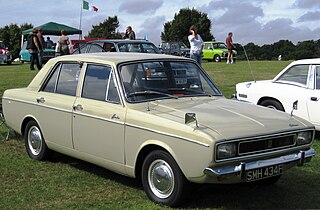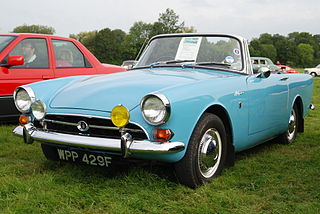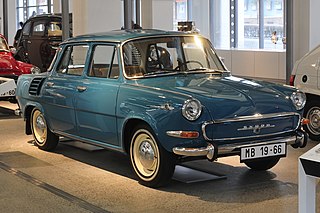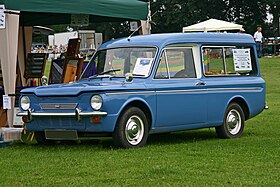
The Ford Anglia is a compact car which was designed and manufactured by Ford UK. It is related to the Ford Prefect and the later Ford Popular. The Anglia name was applied to various models between 1939 and 1967.

Hillman is a British automobile marque created by the Hillman Motor Car Company, founded in 1907. The company was based in Ryton-on-Dunsmore, near Coventry, England. Before 1907 the company had built bicycles. Newly under the control of the Rootes brothers, the Hillman company was acquired by Humber in 1928. Hillman was used as the small car marque of Humber Limited from 1931, but until 1937 Hillman did continue to sell large cars. The Rootes brothers reached a sixty per cent holding of Humber in 1932 which they retained until 1967, when Chrysler bought Rootes and bought out the other forty per cent of shareholders in Humber. The marque continued to be used under Chrysler until 1976.

Rootes Arrow was the manufacturer's name for a range of cars produced under several badge-engineered marques by the Rootes Group from 1966 to 1979. It is amongst the last Rootes designs, developed with no influence from future owner Chrysler. The range is almost always referred to by the name of the most prolific model, the Hillman Hunter.

The Hillman Imp is a small economy car made by the Rootes Group and its successor Chrysler Europe from 1963 until 1976. Revealed on 3 May 1963, after much advance publicity, it was the first British mass-produced car with the engine block and cylinder head cast in aluminium.

Commer was a British manufacturer of commercial vehicles from 1905 until 1979. Commer vehicles included car-derived vans, light vans, medium to heavy commercial trucks, military vehicles and buses. The company also designed and built some of its own diesel engines for its heavy commercial vehicles.

The Hillman Minx was a mid-sized family car that British car maker Hillman produced from 1931 to 1970. There were many versions of the Minx over that period, as well as badge-engineered variants sold by Humber, Singer, and Sunbeam.

The Ford Squire is a car that was produced by Ford UK from 1955 to 1959.

The Triumph Herald is a small two-door car introduced by Standard-Triumph of Coventry in 1959 and made through to 1971. The body design was by the Italian stylist Giovanni Michelotti, and the car was offered in saloon, convertible, coupé, estate and van models, with the latter marketed as the Triumph Courier.

The Sunbeam Alpine is a two-seater sports drophead coupé produced by Rootes Group from 1953 to 1955, and then 1959 to 1968. The name was then used on a two-door fastback from 1969 to 1975. The original Alpine was launched in 1953 as the first vehicle from Sunbeam-Talbot to bear the Sunbeam name alone since Rootes Group bought Clément-Talbot, and later the moribund Sunbeam from its receiver in 1935.

The Singer Gazelle name has been applied to two generations of motor cars from the British manufacturer Singer. It was positioned between the basic Hillman range and the more sporting Sunbeam versions.

The Humber Sceptre is an automobile which was produced in the United Kingdom from 1963 to 1976 by Humber.

The Sunbeam Rapier is an automobile produced by Rootes Group from 1955 to 1976, in two different body-styles, the "Series" cars and the later (1967–76) fastback shape, part of the "Arrow" range.

The Škoda 1000 MB and Škoda 1100 MB are two rear-engined, rear-wheel drive small family cars that were produced by Czechoslovak manufacturer AZNP in Mladá Boleslav between 1964 and 1969. The 2-door coupé versions of the 1000 MB and 1100 MB were called the 1000 MBX and 1100 MBX.

The Riley Nine was one of the most successful light sporting cars produced by the British motor industry in the inter war period. It was made by the Riley company of Coventry, England with a wide range of body styles between 1926 and 1938.
The Singer Vogue name has been applied to two generations of motor cars from the British manufacturer Singer.

The Humber Hawk is a four-cylinder automobile manufactured from 1945 to 1967 by British-based Humber Limited.

The Hillman Super Minx is a family car which was produced by Hillman from 1961 to 1967. It was a slightly larger version of the Hillman Minx, from the period when the long-running Minx nameplate was applied to the "Audax" series of designs.

The Hillman Fourteen is a medium-sized 4-cylinder car announced by Hillman's managing director Spencer Wilks, a son-in-law of William Hillman, at the end of September 1925. This new Fourteen substantially increased Hillman's market share and remained on sale into 1931. During this time it was the main product of the company.

The Isuzu Hillman Minx was a series of middle-sized family cars produced by Isuzu Motors in Japan under licence from the Rootes Group between 1953 and 1964. The models were broadly equivalent to the Hillman Minx Mark VI to Mk VIII and Series 1 to Series 3A produced at the same time in the UK, although some notable divergence occurred in the later years as production became localised in Japan.

The Commer FC was a commercial vehicle produced by Commer from 1960 to 1976. During its lifespan, it was developed into the Commer PB in 1967, and the Commer SpaceVan in 1974. After the Rootes Group, which owned Commer, was purchased by Chrysler, the SpaceVan was also sold under the Dodge and Fargo marques. From 1976 onwards, the van was only sold as the Dodge SpaceVan, and it remained in production until 1983.


























